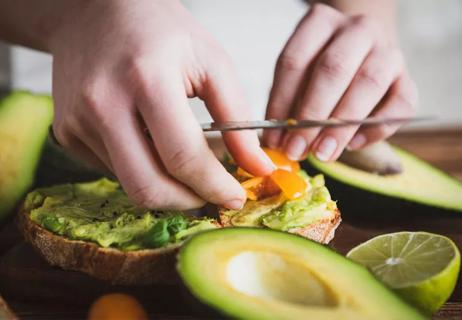Is margarine or butter better for your heart?

Butter. Yogurt butter. Olive-oil margarine. There’s no end to the variety of spreads available today. How do you know which ones are healthy for your heart?
Advertisement
Cleveland Clinic is a non-profit academic medical center. Advertising on our site helps support our mission. We do not endorse non-Cleveland Clinic products or services. Policy
“Sure, butter is creamy and spreadable, but it provides a significant source of saturated fat which in excess can lead to elevated blood cholesterol,” says preventive cardiology dietitian Julia Zumpano, RD, LD. “Margarine, made from plant-based fats and oils, is supposedly heart-healthier. However, not all margarine is created equal. Most margarines contain unhealthy plant oils in order to keep them solid.”
Zumpano breaks down nine types of spreads that you should keep your eye out for:
1. Butter – 100 calories and 7 grams of saturated fat in one tablespoon
Butter is high in saturated fat and cholesterol, which can push you past daily limits for saturated fat (10 to 15 grams) and cholesterol (200 mg), increasing the risk of heart disease.
2. Light butter – 50 calories and 3.5 grams of saturated fat in one tablespoon
Light butter has half the calories, saturated fat and cholesterol of butter.
3. Light butter blended with oil – 50 calories and 2 grams of saturated fat in one tablespoon
This blend of light butter and oil has heart-healthy monounsaturated and polyunsaturated fats (MUFAs and PUFAs).
4. Yogurt butter – 45 calories and 1.5 grams of saturated fat in one tablespoon
Yogurt butter is a blend of nonfat yogurt, vegetable oils (soybean, palm, palm kernel and canola) and water. Low-fat and lowest in calories, it can help you with weight loss.
Advertisement
5. Margarine- 60 to 100 calories with 0.5 to 2 grams of saturated fat in one tablespoon
Margarine may contain trans fat, which raises LDL (bad) cholesterol, lowers HDL (good) cholesterol and makes blood platelets stickier, increasing heart disease risk. Margarine containing hydrogenated or partially hydrogenated oils contain trans fats and should be avoided.
6. Light margarine – 40 to 45 calories with 4.5 to 5 grams of saturated fat in one tablespoon
Light margarine contains less saturated and trans fat than regular margarine.
7. Margarine with phytosterols – 70 calories with 1 gram of saturated fat in one tablespoon
A spread with heart-healthy plant sterols or stanols; 2 grams per day can help lower LDL cholesterol if your diet is low in saturated fat and cholesterol.
8. Light margarine with phytosterols – 45 to 50 calories with 1 gram of saturated fat in one tablespoon
This light margarine has fewer calories and fat than regular margarine.
9. Vegan olive oil spread – 80 calories and 2 to 3 grams of saturated fat in one tablespoon
A vegan olive oil spread is a blend of canola, palm-fruit and olive oils with MUFAs that can increase HDL, lower LDL and reduce inflammation if you follow a heart-healthy diet.
When it comes to choosing between margarine and butter, the real answer is that neither is a good choice.
Avoid solid fats and choose mainly liquid oils like extra virgin olive oil. If you can’t give up the solid fat and are willing to use it in moderation, you can limit to 1 teaspoon of real unsalted butter because it provides 2.3 grams of saturated fat, which is the least processed choice. Otherwise, choose a butter olive oil blend which provides 2.3 grams of saturated fat for 1 tablespoon if you would like more volume. Keep in mind all other butter blends or margarines contain unhealthy plant oils and additives such as food coloring, fillers and gums.
“Replacing all saturated fat in your diet with MUFAs and PUFAs can lower bad cholesterol,” she says. “If you can’t give up butter and don’t have heart disease, make sure you aren’t getting more than 10 to 15 grams of saturated fat per day.”
But what keeps butter and margarine solid at room temperature? In butter, it’s saturated fat (also in full-fat dairy products and red meat). In margarine, it’s trans fat that’s created when hydrogen is used to harden vegetable oil. More often, for tub margarine, plant-based solid fats are used such as palm or palm kernel oils.
Advertisement
Many stick margarines may contain trans fat, so tubs are usually better.
For heart health, try brushing your bread or toast with olive oil. Become an expert label reader at the grocery store and always check ingredients on the label. Be aware that even margarine that’s advertised with zero trans fat may contain up to 0.5 grams.
“The take home message is to use extra virgin olive oil most often, read labels and check ingredients for any solid spreads to minimize saturated fat and unhealthy oils,” says Zumpano. “If most of the fat is heart-healthy monounsaturated or polyunsaturated fat, that’s a good thing. But if there is even a miniscule amount of trans fat, that’s a problem.”
Advertisement
Learn more about our editorial process.
Advertisement

It’s best to avoid regular use of the ‘beef drippings,’ given high levels of saturated fat

This healthy oil is packed with nutrients and great for roasting, drizzling and even baking

The popular cooking method can help you cut down on fat without losing the flavor and texture of your favorite foods

EVOO is full of antioxidants and has anti-inflammatory properties, both of which aid your body in multiple ways

This powerhouse oil fights fine lines and wrinkles, soothes sunburn and a whole lot more

Trace amounts of trans fat can still lurk in your foods, and they can add up

The best cooking oils contain healthier fats, and EVOO wins best in show

You need the right kinds of fats in your diet, but moderation is still key

If you’re feeling short of breath, sleep can be tough — propping yourself up or sleeping on your side may help

If you fear the unknown or find yourself needing reassurance often, you may identify with this attachment style

If you’re looking to boost your gut health, it’s better to get fiber from whole foods